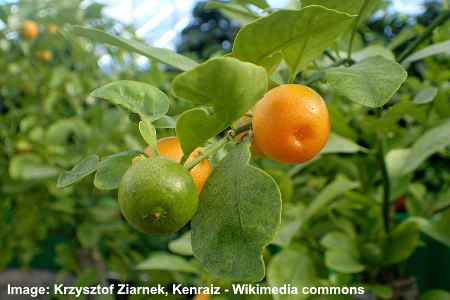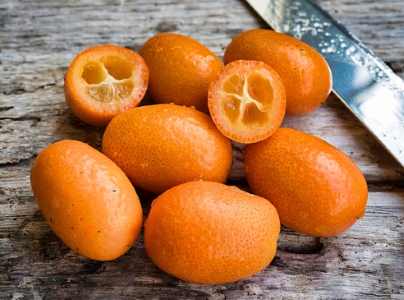Types of Citrus Fruits With their Picture and Classification

The different types of citrus fruits are zesty and tangy and are packed full of flavor. The taste of citrus fruits is a varying combination of sweet and sour flavors that refresh, delight, and invigorate your taste buds. There are over 100 different varieties of citrus fruits. Citrus fruits such as lemons and limes can be so sour, they make your mouth pucker. Others such as oranges are delicious and sweet with a slightly tangy taste.
What are Citrus Fruits?
All the types of citrus fruits that you buy in the store or grow at home are hybrids from the 3 natural citrus fruits. The original species of citrus fruits are pomelo, mandarin orange, and citron.
Citrus is the botanical name for the genus of all fruits classified as citrus fruits. All types of citrus fruits such as oranges, lemons, limes, and grapefruits belong to the family Rutaceae. The tangy fruits in this family generally have juicy segments that are surrounded by a zesty rind.
You can easily tell which are citrus fruits and which are not by their botanical name. All types of citrus fruits will have the name citrus in it. Other tropical fruits such as pineapples, bananas, mangoes, grapes, and peaches are not citrus fruits. They belong to plant genera unrelated to citrus fruits. Other types of fruits such as pomegranate, kiwifruits, and passion fruits are not related to the Citrus genus as well.
Citrus Fruits List
Some popular types of citrus fruits include the following:
- Sweet oranges (Citrus × sinensis) include varieties such as navel oranges, Valencia, Hamlin, and cara cara.
- Bitter oranges (Citrus × aurantium) are usually too sharp and sour to eat raw.
- Lemons (Citrus limon) include hybrids such as Eureka, Bonnie Brae, Meyer, and primofiori.
- Limes are green citrus fruits that include varieties such as Bearss, key limes (Citrus × aurantiifolia), Tahiti lime, and Persian limes (Citrus × latifolia).
- Grapefruits (Citrus × paradisi) are bitter citrus fruits and some popular varieties are Ruby Red, Thompson, Oro Blanco, and Star Ruby.
- Other varieties of citrus fruits are varieties such as kumquats, yuzu, citron, pomelo, and Buddha’s hand.
Types of Citrus Fruits
Let’s look at some of the most popular citrus fruits that you can enjoy at any time of the year. In this list, you will also come across some less well-known varieties of citrus fruit that may be worth trying.
Orange
Oranges are one of the most-loved citrus fruits due to their sweet taste and many benefits. All varieties of oranges are hybrids from 2 of the natural citrus fruits – pomelo and mandarin. Sweet oranges can range in size from small Hamlin varieties to large navel oranges with thick orange rind.
- Scientific name: Citrus x sinensis.
- Country of origin: China, but now one of the most cultivated fruits in the world.
Tangerine
Tangerines look like small oranges and have a sweet taste and skin that peels easily. The name ‘tangerine’ comes from the fact that the original orange hybrids came from Tangier, Morocco. Tangerines are a mandarin orange hybrid that has been crossed with pomelo. Compared to oranges, tangerines have a less rounded shape and stronger sweet taste.
- Scientific name: Citrus reticula L. var. or Citrus tangerina.
- Country of origin: Morocco.
Mandarin Orange
Mandarin oranges are one of the original citrus fruits that are used to develop many citrus hybrids. Mandarins look similar to tangerines and the two names are often used interchangeably. When compared to sweet oranges, mandarins are smaller, have a squashed shape, and taste sweeter. You can eat mandarins fresh and the peel is often used for its tangy-sweet zest.
- Scientific name: Citrus reticulata.
- Country of origin: China.
Clementine

Clementine looks like small orange fruit but it’s sweeter and with thinner skin which is easy to peel – it’s one of the most delicious types of fruits
Clementines are seedless small citrus fruits that are related to mandarins. You can tell clementines apart from tangerines because their zesty rind is a deeper orange color. They also have a honey-sweet taste with just slight overtones of sourness. The clementine orange is a cross between a mandarin and sweet orange.
- Scientific name: Citrus × clementina.
- Country of origin: Algeria.
Satsuma
Satsumas are a type of mandarin orange or tangerine and are seedless citrus fruits that taste deliciously sweet. These small, easy-peeling oranges are also called satsuma orange and satsuma mandarin. One of the reasons why satsumas are so popular is due to their intense sweetness. Although similar in appearance to mandarin oranges, they have a thinner skin and a more delicate flesh.
- Scientific name: Citrus unshiu.
- Country of origin: China.
Blood Orange
You can tell a blood orange from a regular sweet orange by the red blushing on its orange skin and deep red flesh. These citrus fruits belong to the sweet orange classification and taste like raspberries. The red-colored juicy segments get their color from anthocyanins. These are a type of antioxidant that have many benefits and make blood oranges unique among all the citrus fruit varieties. Although they look different from traditional sweet oranges, they are not a hybrid but a natural mutation.
- Scientific name: Citrus x sinensis.
- Country of origin: China.
Lime

Lime is a green citrus fruit – there are many types of limes
Limes are green-colored citrus fruits that have a sour taste and are not as sweet as lemons. There are a number of types of limes with the Key lime and Persian lime varieties being the most common. Limes generally have green rind and greenish-yellow flesh. You can tell when limes are ripe because their skin turns yellowish.
- Scientific name: Citrus × aurantiifolia (Key lime), Citrus × latifolia (Persian lime).
- Country of origin: Southeast Asia.
Kaffir Lime
Kaffir limes are another green citrus fruit that has a sharp bitter taste. In Asian cuisine, the leaves of the Kaffir lime tree are used more often than the fruit. Kaffir lime leaves have a lemony-lime taste and add flavor to Thai, Indonesian, and other Asian dishes.
- Scientific name: Citrus hystrix.
- Country of origin: Asia.
Philippine Lime (Calamansi)
The Philippine lime (Calamansi) is a small round citrus hybrid that’s very common in the Philippines. The Philippine lime looks like a traditional lime but it has orange-colored flesh that resembles a tangerine. These small orange and green citrus fruits are also called calamondin or calamansi. The Philippine lime is a cross between a kumquat and a mandarin orange.
- Scientific name: Citrus microcarpa,× Citrofortunella microcarpa or × Citrofortunella mitis
- Country of origin: Philippines.
Finger Limes
One of the most unusual of the green citrus fruits is the finger lime. This citrus fruit gets its name from the fact it is shaped like a finger. Another unusual feature of finger limes is that its juice vesicles are not tear-shaped like regular limes but look like small pearls. This is why they are also called caviar limes. These citrusy fruits are a popular gourmet food with red, pink, and blue-green varieties being popular.
- Scientific name: Citrus australasica.
- Country of origin: Australia.
Rangpur Lime
Although called a lime, the Rangpur citrus fruit looks more like an orange or mandarin than a Persian lime. Rangpur limes have a sharp acidic taste similar to limes but their peel and flesh are orange like a tangerine. These orange limes are the result of crossing the citron and mandarin orange.
- Scientific name: Citrus × limonia.
- Country of origin: Rangpur, Bangladesh.
Lemon
When you think about citrus fruits, lemons are usually the first type of zesty fruit that comes to most people’s minds. These yellow citrus fruits are small to medium-sized and have a sour taste. Lemons are also extremely healthy with the juice of one average-sized lemon containing nearly 65% of your daily vitamin C intake. Common varieties of lemons include Eureka, Lisbon, Meyer, and Primofiori.
- Scientific name: Citrus limon.
- Country of origin: Northeast India or China.
Citron
Citron is one of the 3 original citrus fruits from which all other varieties of citrus fruits are derived from. This is a large citrus fruit that can grow up to 12” (30 cm) long. Because the flesh is not juicy and virtually tasteless, it is rarely used in cooking. However, the thick citrus rind is tangy and used as a food in Asian and Middle-Eastern cuisine. The rind is also candied and used in desserts and cakes.
- Scientific name: Citrus medica.
- Country of origin: India.
Grapefruit

Grapefruit is a large citrus fruit and there are many types of grapefruit
Another large variety of subtropical citrus fruit is the grapefruit. These smooth-skinned fruits get their name because the round fruits grow on the tree in clusters like grapes. Grapefruits can have pink, yellow, or red fleshy segments covered by a yellow-orange rind. Usually, red grapefruits are the sweetest varieties whereas other types are more sour-bitter. Grapefruits are a hybrid of pomelo and sweet oranges.
- Scientific name: Citrus × paradisi.
- Country of origin: Jamaica or Barbados.
Tangelo
The tangelo is a sweet aromatic citrus fruit that has a deep orange rind and orange segments. This tangy citrus fruit is a cross between a tangerine and pomelo and has a taste similar to mandarins. Its name is also a combination of these fruits. Tangelo fruits are about the size of a fist and are recognized by their nipple-like shape at the stem end.
- Scientific name: Citrus × tangelo.
- Country of origin: USA.
Jamaican Tangelo (Ugly Fruit)

Jamaican Tangelo (ugly fruit) has greenish-yellow skin that turns orange when the fruit is fully ripe
The Jamaican tangelo is also a cross between a tangerine and pomelo and has a distinct shape with a wide bottom and slightly pointed end. Its unsightly appearance is the reason why it also gets the name ‘ugly fruit.’ What this large citrus fruit lacks in looks, it makes up for in taste. It has sweet juicy citrus segments with some hints of bitterness.
- Scientific name: Citrus reticulata × paradise.
- Country of origin: Jamaica.
Kumquat
Kumquats are tiny citrus fruits that taste like an orange with bit of sourness but are about the size of a large olive or grape. These are a unique type of citrus fruit because you can enjoy them straight off the tree. Their rind is thin and edible and tastes delicious. There are a number of varieties of kumquat that can be round or oval-shaped. Kumquats have the honor of being the smallest variety of orange.
- Scientific name: Citrus japonica.
- Country of origin: South Asia and the Asia-Pacific region.
Pomelo
One of the botanical names for pomelo is Citrus grandis and this is certainly one of the largest citrus fruits. Along with the citron and mandarin orange, pomelo is classed as one of the natural species of citrus fruits. The most common types of pomelo fruits are characterized by their thick rind and sweet white flesh without any hints of bitterness.
- Scientific name: Citrus maxima.
- Country of origin: Southeast Asia
Yuzu
If you were to look at pictures of yuzu fruits, you think that you are looking at a small type of grapefruit. Unlike grapefruits, yuzu fruits have bumpy skin and are more of a yellow color than orange. The fleshy citrus segments of yuzu are rarely used as food. In Japanese and Korean cuisines, the juice and rind are mostly used to make beverages or desserts as they are very aromatic.
- Scientific name: Citrus junos
- Countries of origin: Central China and Tibet
Buddha’s Hand
One of the most unusual-looking citrus fruits you will come across is the highly aromatic type of citron called Buddha’s hand. Its common name of fingered citron is appropriate as the fruit grows in finger-like sections. Some varieties of these large citrusy fruits can also resemble baseball gloves. The flesh of Buddha’s Hands is not used as food, only the zesty rind is used in desserts, savory dishes, or to flavor alcoholic drinks.
- Scientific name: Citrus medica var. sarcodactylis
- Country of origin: China or India
Kinnow
It can be difficult to tell a kinnow orange apart from a mandarin. This orange-colored citrus fruit is a hybrid of Citrus nobilis and Citrus deliciosa. These medium-sized orange fruits taste sourer than regular oranges but are much juicier. Also, they are more difficult to peel and the original species of kinnow contains many seeds.
- Scientific name: Citrus nobilis x Citrus deliciosa
- Countries of origin: India and Pakistan
Bitter Orange
As its name suggests, bitter oranges are a very sour type of citrus fruit. In fact, the bitter pulp is inedible in its raw state. Also known as Seville oranges, these tart fruits have a rough dimpled skin that is thicker than sweet oranges. The peel is usually used in culinary recipes to make British marmalade, pickled oranges in Tamil cuisine, and a flavoring for gingerbread in Scandinavia.
- Scientific name: Citrus × aurantium.
- Countries of origin: Southeast Asia.
Bergamot Orange
Bergamot oranges are aromatic citrus fruit about the size of an orange and look like large limes. However, this sour orange doesn’t smell or taste like any variety of orange or lime. The essential oils from bergamot orange rinds are the main flavor of Earl Gray tea. Other ways to use bergamot oranges as food are in marmalades, to flavor Turkish delights, or create aromatic liqueurs.
- Scientific name: Citrus bergamia.
- Countries of origin: Southeast Asia.
Related articles:
- Amazing Varieties of Lime (with Pictures)
- Types of Lemons with Pictures
- Grapefruit Varieties From Around the World



















